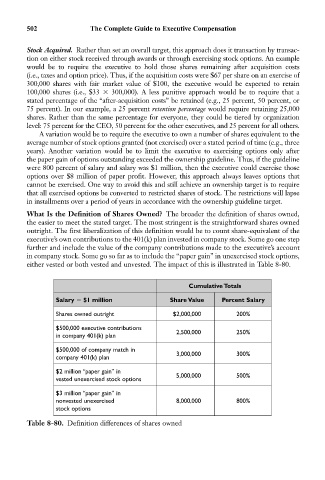Page 516 - Bruce Ellig - The Complete Guide to Executive Compensation (2007)
P. 516
502 The Complete Guide to Executive Compensation
Stock Acquired. Rather than set an overall target, this approach does it transaction by transac-
tion on either stock received through awards or through exercising stock options. An example
would be to require the executive to hold those shares remaining after acquisition costs
(i.e., taxes and option price). Thus, if the acquisition costs were $67 per share on an exercise of
300,000 shares with fair market value of $100, the executive would be expected to retain
100,000 shares (i.e., $33 300,000). A less punitive approach would be to require that a
stated percentage of the “after-acquisition costs” be retained (e.g., 25 percent, 50 percent, or
75 percent). In our example, a 25 percent retention percentage would require retaining 25,000
shares. Rather than the same percentage for everyone, they could be tiered by organization
level: 75 percent for the CEO, 50 percent for the other executives, and 25 percent for all others.
A variation would be to require the executive to own a number of shares equivalent to the
average number of stock options granted (not exercised) over a stated period of time (e.g., three
years). Another variation would be to limit the executive to exercising options only after
the paper gain of options outstanding exceeded the ownership guideline. Thus, if the guideline
were 800 percent of salary and salary was $1 million, then the executive could exercise those
options over $8 million of paper profit. However, this approach always leaves options that
cannot be exercised. One way to avoid this and still achieve an ownership target is to require
that all exercised options be converted to restricted shares of stock. The restrictions will lapse
in installments over a period of years in accordance with the ownership guideline target.
What Is the Definition of Shares Owned? The broader the definition of shares owned,
the easier to meet the stated target. The most stringent is the straightforward shares owned
outright. The first liberalization of this definition would be to count share-equivalent of the
executive’s own contributions to the 401(k) plan invested in company stock. Some go one step
further and include the value of the company contributions made to the executive’s account
in company stock. Some go so far as to include the “paper gain” in unexercised stock options,
either vested or both vested and unvested. The impact of this is illustrated in Table 8-80.
Cumulative Totals
Salary $1 million Share Value Percent Salary
Shares owned outright $2,000,000 200%
$500,000 executive contributions
2,500,000 250%
in company 401(k) plan
$500,000 of company match in
3,000,000 300%
company 401(k) plan
$2 million “paper gain” in
5,000,000 500%
vested unexercised stock options
$3 million “paper gain” in
nonvested unexercised 8,000,000 800%
stock options
Table 8-80. Definition differences of shares owned

